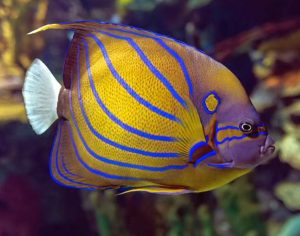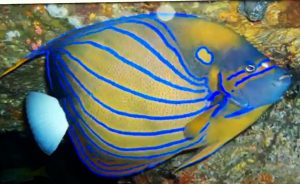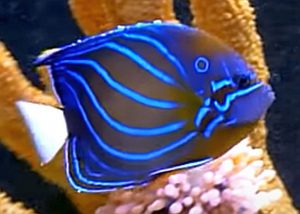Annularis Angelfish (Pomacanthus annularis) known to tropical fish keeping enthusiasts as the Blue Ring Angelfish or Blue King Angelfish is found throughout the Indo West Pacific which includes East Africa (north of Natal), Madagascar, Sri Lanka, Indonesia east to New Guinea and the Solomon Islands, and north to southern Japan.
Annularis Angelfish are found on coastal reefs at depths to 200 feet where they feed on zooplankton, tunicates, and sponges in singles or in pairs.
Annularis Angelfish have a dark blue to black body color with thin alternately spaced white and light baby blue, well spaced curved strips on their sides and a transparent caudal fin. The backward curved stripes resemble shallow crescents.
Adult Annularis Angelfish are a golden brown color with sapphire blue horizontal stripes radiating from the base area of the pectoral fin along the sides towards the posterior portion of the dorsal fin. The brilliant blue stripes along the flanks are well spaced and curve slightly towards the belly. Two blue stripes run horizontally across the face with one running from above the snout to the edge of the operculum, directly through the eye.
The brilliant blue stripes continue through the the dorsal and anal fins. A distinct blue ring is situated behind and slightly above the edge of the operculum (hence it’s name) and the caudal fin is white with a bright yellow margin.
Juvenile Queen Angelfish (Holacanthus ciliaris) and Blue Angelfish (Holacanthus bermudensis) both have similar vertical blue body bars. No other Atlantic angelfish has blue body markings.
Because Blue Ring Angelfish are hermaphroditic, it is not visually possible to differentiate males from females.
Annularis Angelfish are a relatively large, semi aggressive species that should be housed in a tank of at least 220 gallon capacity with an abundance of live rock for grazing; arranged into caves, overhangs, and crevices for them to hide among. Unless you plan to try to breed a pair, only one Annularis Angelfish should be housed per tank.
Some tropical fish keeping enthusiasts have managed to keep Annularis Angelfish in a reef setting, but because they will will nip at sessile invertebrates such as nudibranchs, tridacnid clams, and SPS corals; Pomacanthus annularis are not considered reef safe. The safest corals to keep with this species is bubble corals, disc anemone, hammer corals, star polyps, and small polyped stony corals.
Compatible tank mates include Blennies, Damselfish, Cardinals, Hawkfish, Tangs, and Wrasses.
Annularis Angelfish are pelagic egg scatterers that form monogamous pairs but to date have not been bred in an aquarium environment. They are commercially bred for sale to the aquarium trade in Sri Lanka and Indonesia.
In their natural environment, Blue Ring Angelfish are omnivores that graze on algae, sponges, zooplankton, and tunicates. In an aquarium environment, they require a mixed diet of vegetables, meats, and commercial angel food preparations that must include sponges. Initially, they should be offered live brine shrimp or freshly chopped fish, squid, or shrimp until they become aggressive eaters.
Both adult and juvenile Annularis Angelfish (Pomacanthus annularis) are available to tropical fish keeping enthusiasts from a variety of sources online and from local tropical fish shops in various sizes. Always request hand netted specimens rather than those collected using chemicals and make sure that your supplier provides a survival guarantee before you purchase one.
The approximate purchase size for Blue Ring Angelfish are: Juvenile Small: 1″ to 1 3/4″; Medium: 1 3/4″ to 2″; Large: 2″ to 2 3/4″; Sub Adult/Changing: Small; 2″ to 2-3/4″; Medium: 2 3/4″ to 3″; Medium/Large: 3″ to 3-1/2″; Large: 3-1/2″ to 4″; Adult Small: 3″ to 3 1/2″; Medium: 3 1/2″ to 4″; Medium/Large: 4″ to 5″; Large: 5″ to 6″; X Large: 6″ to 7″; Show Size: 8″ to 9″.
Minimum Tank Size: 220 gal
Aquarium Type: Reef Compatible with caution
Care Level: Moderate
Temperament: Semi Aggressive
Aquarium Hardiness: Hardy when acclimated
Water Conditions: 72-78°F, dKH 8 to 12, pH 8.1-8.4, sg 1.020-1.025
Max. Size: 17.5″
Color Form: Blue, Tan, White
Diet: Omnivore
Compatibility: Community
Origin: Indonesia, Sri Lanka (captive bred)
Family: Pomacanthidae
Lifespan: 15 to 20 years
Aquarist Experience Level: Intermediate





One Response to “Annularis Angelfish (Pomacanthus annularis)”
Trackbacks/Pingbacks
[…] Juvenile Old Woman Angelfish are much more colorful, almost indistinguishable from juveniles of Pomacanthus annularis, and frequently misidentified by tropical fish keeping […]